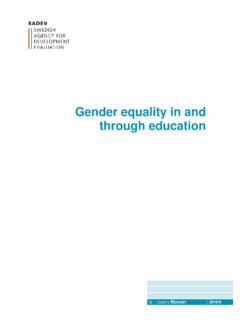Transcription of Corporate governance - CALMEADOW
1 Corporate governance in microfinance institutions Pasquale Di Benedetta, Ira W. Lieberman , and Laura Ard governance affects the way an organization is directed, administered and/or controlled. Good governance can go a long way in preparing an MFI to better handle the risks that are inherently part of managing an MFI. Risk taking is at the heart of financial intermediation and the Board of Directors is ultimately responsible for the level of risk assumed by the institution. Corporate governance in microfinance institutions Pasquale Di Benedetta, Ira W. Lieberman , and Laura Ard 2015 International bank for Reconstruction and Development / The World bank 1818 H Street NW. Washington DC 20433. Telephone: 202-473-1000. Internet: This work is a product of the staff of The World bank with external contributions. The findings, interpretations, and conclusions expressed in this work do not necessarily reflect the views of The World bank , its Board of Executive Directors, or the governments they represent.
2 The World bank does not guarantee the accuracy of the data included in this work. The boundaries, colors, denominations, and other information shown on any map in this work do not imply any judgment on the part of The World bank concerning the legal status of any territory or the endorsement or acceptance of such boundaries. Rights and Permissions The material in this work is subject to copyright. Because The World bank encourages dissemination of its knowledge, this work may be reproduced, in whole or in part, for noncommercial purposes as long as full attribution to this work is given. Any queries on rights and licenses, including subsidiary rights, should be addressed to the Office of the Publisher, The World bank , 1818 H Street NW, Washington, DC 20433, USA; fax: 202-522-2422; e-mail: The World bank Graphic Design: Miki Fern ndez, We gratefully acknowledge CALMEADOW Foundation for their support in publishing this document.
3 N n 3. FOREWORD. As microfinance institutions (MFIs) scale up and commercialize, proper MFI. governance becomes increasingly important. Current microfinance literature and forums do not sufficiently address MFI governance . The topic is not as sexy' as mobile or branchless banking, new product development or credit crisis. Yet good MFI governance plays a crucial role in product development, technological advancement, and more importantly, crisis management. governance affects the way an organization is directed, MFIs often operate in regions prone to natural or administered and/or controlled. Good governance can go socio-political crises (Nicaragua, Bosnia, Morocco and a long way in preparing an MFI to better handle the risks India are popular examples). During a crisis, the board that are inherently part of managing an MFI. Risk taking plays a critical role in ensuring the viability of the MFI.
4 Is at the heart of financial intermediation and the Board Weathering the Storm by Daniel Rozas and Failures of Directors is ultimately responsible for the level of risk in Microfinance by Beatriz Marulanda and others have assumed by the institution. documented institutional failures across the global micro- Boards should be making decisions that will result in fi- finance industry. The cardinal lesson in all those cases is nancial and organizational health, maintain mission that good MFI governance could have prevented or mit- focus, and assure institutional reputation and market po- igated the crises these MFIs faced. In most cases, they sitioning. Not only does the board appoint and review the could have prevented failure altogether. performance of the CEO but it should also decide which business opportunities to pursue, which market niches MFIs need to learn from the experiences of their peers are of interest, which products to introduce, and which that struggled before them.
5 Development institutions and policies and procedures best support the organization. private investors are uniquely positioned to encourage And as MFIs' operational and decision making complexity MFIs to do so. Holding a substantial equity stake, these has increased, so has the importance of good MFI gover- investors often play a prominent role on the boards of nance. Increased MFI complexity is exemplified in: MFIs. But before investors and stakeholders can push for better governance practices, they must first acknowledge As MFIs have scaled up, their management has be- and internalize why good governance is important par- come more complex due to greater outreach, product ticularly for an industry that is rapidly maturing. diversification, and entry into different markets. This background paper on microfinance governance aims Many MFIs have transformed into regulated entities to greatly advance our thinking in the industry on why gov- and face the regulatory requirements associated with ernance is of such critical importance to MFIs, now more such a transformation.
6 Than ever. We hope it will shed some light in areas that Scaling up and transformation requires additional, het- previously might have gone unnoticed and prompt MFI. erogeneous funding and the financial prudence and stakeholders, DFIs and MIVs, to pay more attention to gov- guidance that implies. ernance; in turn encouraging MFIs to improve their gover- Multinational MFI organizations (both global and re- nance principles. gional) face different governance standards requiring strong direction to keep the organization focused. Alex Silva MFIs are maturing and many institutions are beginning CALMEADOW Foundation to face succession issues for the first time. September 2014. ACRONYMS. BANEX Banco del Exito, Nicaragua BRI bank Rakyat of Indonesia BIO Belgian Investment bank for Developing Countries BRAC Bangladesh Rural Advancement Committee CEO Chief Executive Officer CGAP Consultative group to Assist the Poor CMEF The Council of Microfinance Equity Funds DFI Development Financial Institution EBL Equity bank Limited of Kenya FINCA Foundation for International Community Assistance FMO Entrepreneurial Development bank , Netherlands IIC Inter-American Investment Corporation at IADB.
7 IMF International Monetary Fund KEP Kosovo Enterprise Program KfW Kreditanstalt f r Wiederaufbau, German Development bank K-Rep bank Commercial Kenyan bank , formerly known as Kenya Rural Enterprise program MD Managing Director MFX Microfinance Exchange MFIs Micro-finance institutions MIS Management Information System MIV Microfinance Investment Vehicle MIX Microfinance Information Exchange MicroRate Rating Agency for MFIs NBFI Non- bank Financial Institutions NGO Non-Government Organization OXFAM Oxford Committee for Famine Relief PROMIFIN Regional Central American Program for Enhancing the Financial Services for low-income populations PROPARCO Branch of the French Development Agency dedicated to Micro Finance SIFEM The Swiss Investment Fund for Emerging Markets SMART The SMART Campaign to promote responsible investment SKS Microfinance Limited SME Small and Medium Enterprises TABLE OF CONTENTS.
8 INTRODUCTION: WHY SHOULD WE BE CONCERNED. ABOUT Corporate governance IN MICROFINANCE? 6. THE EVOLUTION OF THE MICROFINANCE SECTOR 9. A. Historical Evolution 9. B. Characteristics of Microfinance 12. INSTITUTIONAL TYPOLOGIES IN THE MICROFINANCE INDUSTRY 14. Corporate governance : HOW IT EVOLVES IN MFIs AS THEIR STRUCTURE AND OWNERSHIP CHANGE 16. A. The Board 16. B. Social Responsibility: The Role of the Board and Management 17. C. Succession Planning: The Role of Board and Management 28. D. Risk Management of MFIs: Six Recurrent Challenges 18. E. Risk-Management Challenges 20. EXTERNAL FACTORS INFLUENCING governance 30. CONCLUSIONS: INDUSTRY RESPONSES TO governance CHALLENGES 32. A. governance Activities in the Sector 32. B. Proposed Next Steps 32. APPENDIX: WHAT MAKES EXCELLENT INSTITUTIONS IN MICROFINANCE? 34. 6 n n INTRODUCTION. Why Should We Be So Concerned about Corporate governance in Microfinance?
9 The microfinance market today looks much different from 2007. De- spite the worldwide financial crisis, the sector has doubled in size, transformed from mostly an NGO driven market to one increasingly dominated by regulated institutions, experienced a strong expan- sion of savings services, and held its first public listings and merg- ers. Microfinance is displaying the signs of a maturing industry. It has also weathered its first global downturn, lived through several major market crises, and is currently living through a crisis of percep- tions and confidence on whether microfinance actually helps allevi- ate poverty in the first place. None of these issues existed in 2011 MicroRate, MFI Rating Agency INTRODUCTION n n 7. T his paper discusses the Corporate governance of mi- crofinance institutions (MFIs). It is not meant to be comprehensive by any means, but it aims to draw lessons euros at relatively high costs and are bearing the atten- dant foreign exchange risk in event of a devaluation of their local (national) currency.
10 On governance from research studies, data analysis, and case studies of the failure or success of individual MFIs. Product-diversification risk: MFIs are adding new prod- uct lines and are moving away from plain vanilla . governance has been one of the most neglected sub- working capital loans with typical maturities of 12. jects in the microfinance sector. Relatively little has been months or less. They are adding small business loans, written about it, and the efforts of various governance housing-rehabilitation loans, and agricultural loans initiatives have been Recently, however, that may carry different maturities, different payment attention directed toward governance in the sector has terms, and different associated risks. In many cases, increased significantly. insurance, money transfers, remittances, and even Why has it suddenly become so urgent to discuss corpo- mobile banking are becoming part of the mix.



